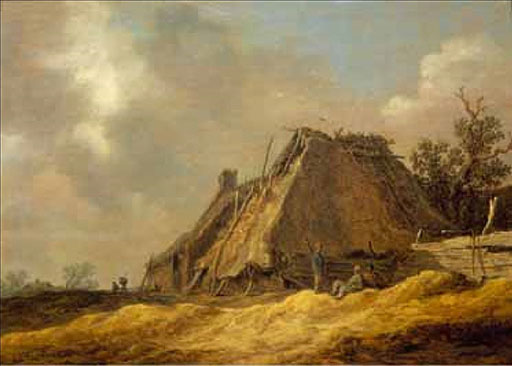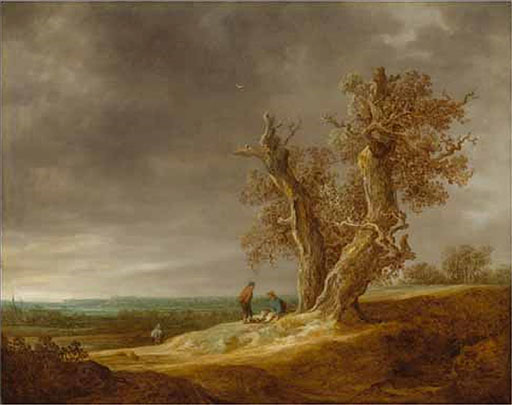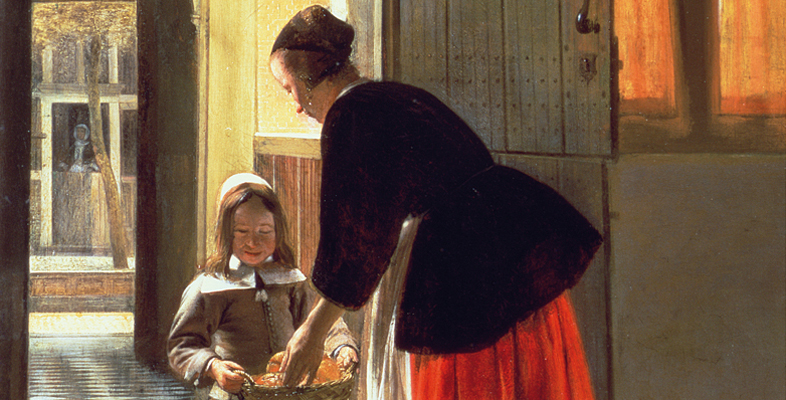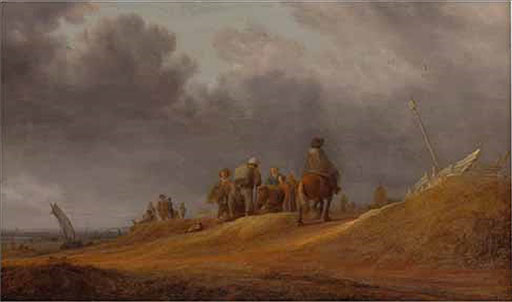Interpreting the Dutch landscape
We can bring these issues into focus by considering Bruyn’s analysis of two small landscapes by van Goyen: Farmhouses with Peasants, which is variously dated to 1630 or 1636 (Figure 21) and Landscape with Two Oaks of 1641 (Figure 22). These paintings belong to the so-called ‘tonal phase’ of Dutch landscape painting, characterised by the use of a restricted palette to depict unprepossessing tracts of land, including river scenes and the dune landscape by the coast, with its sandy soil, scarce vegetation and scattered human dwellings. Bruyn acknowledges that it ‘may come as a surprise to learn that van Goyen’s images dealt so often – or even as a rule – with the transience of a vain world’, but he goes on to identify a number of specific motifs that can be used to support this interpretation. In his account of Landscape with Two Oaks he claims that:
the weather-beaten trees are treated as protagonists, thus emphasizing their symbolization of vanitas. Equally clear is the meaning of the idle, chatting figures, and perhaps the interpretation of the horizon as the end of life, which appears in [a printed text by Jan] Luyken, could be applied to such a panorama. The traveller descending a hill with his back to the viewer might well be the pilgrim, approaching the church in the distance to the left.


Bruyn applies the same reading to Farmhouses with Peasants, arguing that the two tiny figures walking away from the farmhouses should be interpreted as pilgrims. Having noted that one of them carries a long stick with a sack, he observes that ‘It can hardly be fortuitous that the pilgrim on his life’s journey towards heavenly paradise was described during the late Middle Ages as carrying a sack containing his sins on his right shoulder.’ (Bruyn, 1987, p. 95) The weakness of this sort of interpretation lies not so much in the proposal that seventeenth-century viewers may have looked for religious symbolism even in apparently commonplace scenes, but in the way in which it isolates specific motifs from the painting as a whole, which is thereby reduced to a mere composite of elements that can already be found elsewhere. There is little interest in the painting as a painting or the way in which van Goyen has sought to communicate his own particular vision of the Dutch countryside.
In the same exhibition catalogue in which Bruyn’s essay appears, the historian Simon Schama offers a markedly different account of the possible meanings that these paintings may have had for contemporary viewers. Like Bruyn, Schama rejects the realist assumption that Dutch landscape paintings are simply an ‘arbitrary inventory of topographical data’ and both Schama and Bruyn are agreed that such images would have been interpreted in ways that may not be obvious to us today (Schama, 1987, p. 71). However, Schama is far more attentive to the innovative pictorial characteristics of early Dutch landscape painting, recognising that ‘these repeated images of sand, scrubby vegetation, bleak, wind-torn trees, and tattered dwellings’ are without precedent in the art of any other country. For Schama, the explanation for the development of this new type of painting, in which native scenes and habitats are depicted with great intimacy and feeling for locality, is to be found in Dutch patriotism and a ‘loyalty to the homely’ awakened by the vicissitudes of the early seventeenth century (Schama, 1987, p. 68 and 79).
The popularity of dune landscapes, which were also produced by other artists such as Pieter Molyn (1595–1661) and Salomon van Ruysdael (?1600/03–1670) (Figure 23), can be connected not only to the struggle for independence from Spanish rule, but also to the great land reclamation projects through which the Netherlands recovered substantial tracts of land from inland seas. Schama concludes that these paintings must be seen as ‘a highly selective and value-laden presentation of a particular kind of native habitat’ and that they testify to ‘the emergence of a native aesthetic, poetically expressed but normative in its associations’ (Schama, 1987, p. 71). In short, if we wish to discover the meanings that van Goyen’s work possessed for his contemporaries, we should look not – or not only – to the scriptural associations that might have been prompted by Calvinist theology, but also to the rise of Dutch nationalism and to the ‘political geography’ of a country in the process of self-formation.

